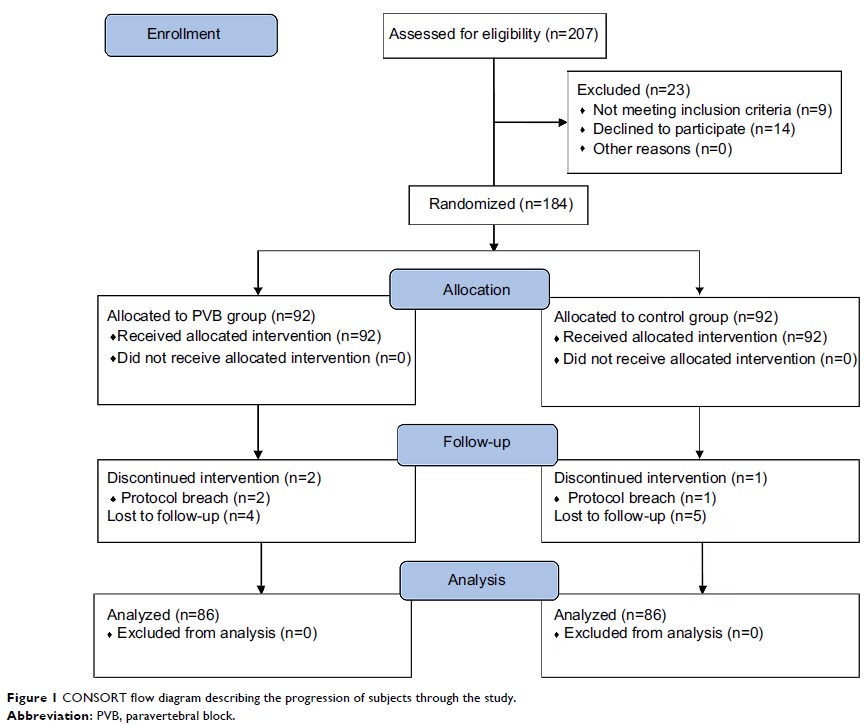108605
论文已发表
注册即可获取德孚的最新动态
IF 收录期刊
- 3.4 Breast Cancer (Dove Med Press)
- 3.2 Clin Epidemiol
- 2.6 Cancer Manag Res
- 2.9 Infect Drug Resist
- 3.7 Clin Interv Aging
- 5.1 Drug Des Dev Ther
- 3.1 Int J Chronic Obstr
- 6.6 Int J Nanomed
- 2.6 Int J Women's Health
- 2.9 Neuropsych Dis Treat
- 2.8 OncoTargets Ther
- 2.0 Patient Prefer Adher
- 2.2 Ther Clin Risk Manag
- 2.5 J Pain Res
- 3.0 Diabet Metab Synd Ob
- 3.2 Psychol Res Behav Ma
- 3.4 Nat Sci Sleep
- 1.8 Pharmgenomics Pers Med
- 2.0 Risk Manag Healthc Policy
- 4.1 J Inflamm Res
- 2.0 Int J Gen Med
- 3.4 J Hepatocell Carcinoma
- 3.0 J Asthma Allergy
- 2.2 Clin Cosmet Investig Dermatol
- 2.4 J Multidiscip Healthc

术前超声引导下多层椎旁阻滞可降低乳房切除术后慢性疼痛的发生率:一项双盲安慰剂对照随机试验
Authors Qian B, Fu S, Yao Y, Lin D, Huang L
Received 9 October 2018
Accepted for publication 3 January 2019
Published 5 February 2019 Volume 2019:12 Pages 597—603
DOI https://doi.org/10.2147/JPR.S190201
Checked for plagiarism Yes
Review by Single-blind
Peer reviewers approved by Dr Justinn Cochran
Peer reviewer comments 2
Editor who approved publication: Dr Michael Ueberall
Purpose: Chronic
postsurgical pain is a challenging problem after breast cancer surgery. This
prospective, randomized, double-blinded, parallel-group, placebo-controlled
trial was conducted to evaluate the influence of preoperative ultrasound-guided
multilevel paravertebral blocks (PVBs) on chronic pain following mastectomy.
Patients and methods: One
hundred eighty-four women were randomized to receive ultrasound-guided
multilevel (T1–T5) PVBs with 5 mL of ropivacaine 0.5% or normal saline
per level. The primary end point was the incidence of chronic pain at 3 months
following mastectomy assessed by the brief pain inventory (BPI), while the
secondary end points were the acute postoperative pain, the number of patients
requiring rescue analgesia, postoperative nausea and vomiting (PONV), side
effects, and chronic pain at 6 months after surgery assessed by the BPI.
Results: A total
of 172 patients completed the study. Ultrasound-guided multilevel PVBs
significantly decreased immediate postoperative pain for the first 12 hours (P <0.001).
Additionally, fewer patients in the PVB group required rescue analgesia in the
first 48 hours postoperatively compared to the control group (5/86 vs 28/86, OR
=0.128, 95% CI: 0.047–0.351, P <0.001). No statistically significant difference
was tested between the two groups (9.3% vs 17.4%, OR =0.419, 95% CI:
0.162–1.087, P =0.068) in the incidence of PONV. At 3 months, the
incidence of chronic pain (BPI average pain score ≥3) was 34.5% and 51.2% (OR
=0.511, 95% CI: 0.277–0.944, P =0.031) in the PVB and control groups, respectively,
and at 6 months, the incidence was 22.1% and 37.2% (OR =0.479, 95% CI:
0.245–0.936, P =0.03), respectively. No complications occurred
during the study.
Conclusion: This
study indicated that perioperative ultrasound-guided multilevel PVBs with
ropivacaine improved acute postoperative pain and decreased postmastectomy
chronic pain at 3 and 6 months postoperatively.
Keywords: breast cancer
surgery, multimodal analgesia, thoracic paravertebral block, acute
postoperative pain, chronic postsurgical pain
